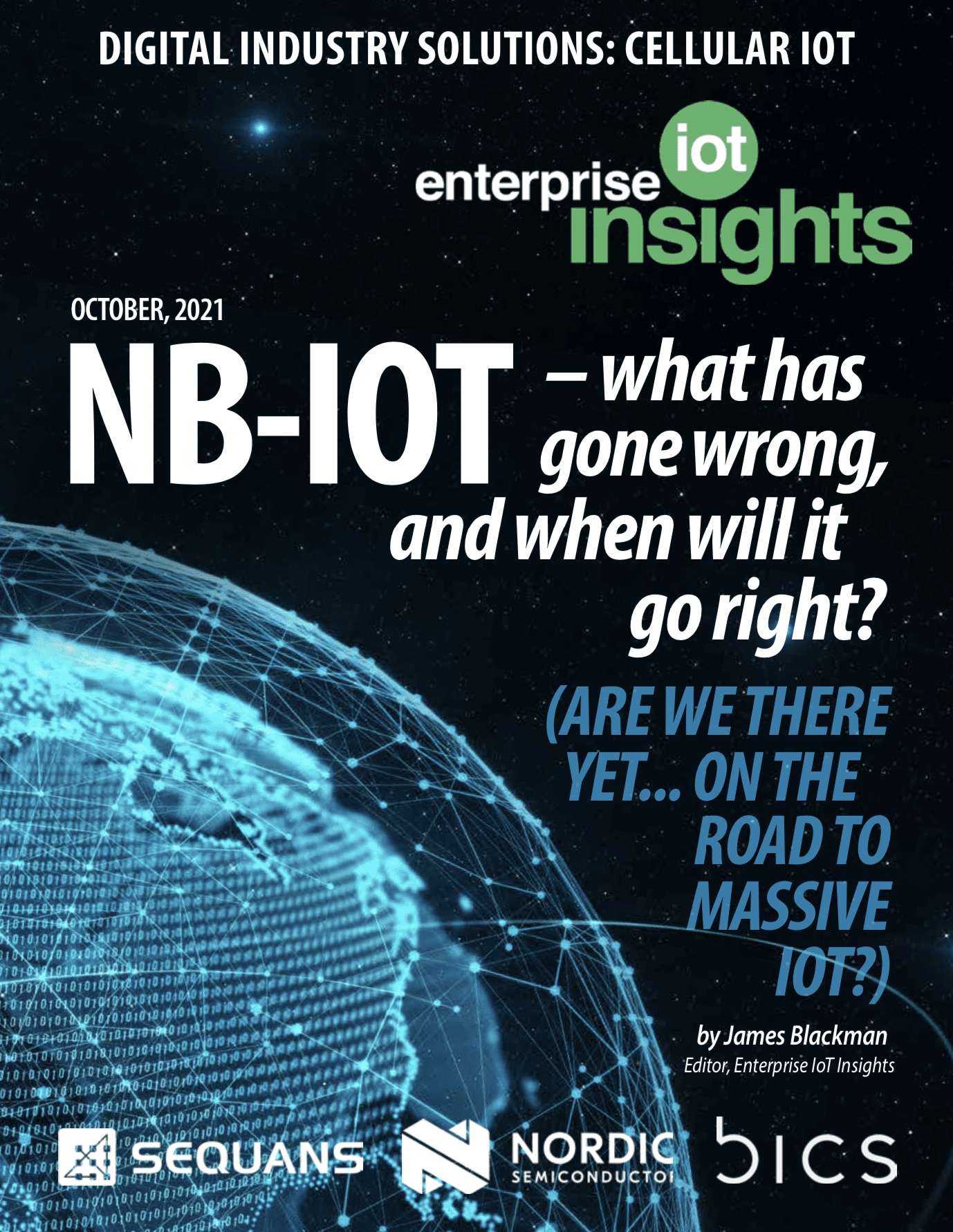This article is continued from a previous entry, covering key NB-IoT challenges 1-5 – which is available here. Both articles are taken from a new report, entitled NB-IoT – what has gone wrong, and when will it go right? The full report is available here. A webinar on the same topic is available here, with panellists from BICS, Sequans, and Nordic Semiconductor.
6 | SILICON SHORTAGES
The impact of the global chip crisis, the result of the Covid-19 pandemic, plus lesser snowballing factors, has been widely reported on the automotive industry, and in consumer electronics. But the industrial IoT market has been damaged, as well. “Oh, it’s terrible, across everything. We are so under-served on wafers; we could have sold a lot, lot more this year – on everything we do,” reflects Svein-Egil Nielsen, chief technology officer at Nordic Semiconductor.
![]()
Diminishing supply has been exacerbated by spiralling demand; reports claim Covid-19 has obliged society to track a variety of assets, from vaccine shipments to social distancing. It has provided the asset tracking market with a fillip, even as whole industrial sectors have gone into lockdown for most of 2020. UK satellite comms provider reckons 84 percent of global companies, across various industrial sectors, are accelerating IoT in response to Covid-19. IoT consultancy Eseye says Covid-19 has impacted the IoT plans of 98 percent of US and UK enterprises.
But the chips are down. For Nordic Semiconductor, which claims a decent ‘pipe’ of business, and describes recent margins on its new line of cellular IoT products as going “from meaningless to meaningful”, the disjunct is not about to be resolved any time soon. “The delay is enormous. We prioritised the [cellular IoT SoC] nRF9160 this year, but we could have shipped so much more. It has been a terrible year, and it will be a terrible year next year, as well.”
7 | HARDWARE CERTIFICATION
Anything to add? The question goes to Svein-Egil Nielsen, at the end of our conversation (see pages 10-14 in report). Yes, it turns out; Nielsen has a beef about IoT hardware certifications, as the last (maybe) roadblock for massive IoT. “One of the things with NB-IoT and LTE-M is this problem of scale, [and the task] to build solutions that are easy, and the biggest obstacles to that is the carriers. They treat every IoT device like a mobile phone, and run it through the ringer with these extremely complicated certification processes,” he says.

“They have not delivered on their promise to make cellular IoT an easy solution to deploy. Some carriers want to test everything. Which is absurd because we are running the same checks [with everyone else]. You change the firmware, and you have to go back to run millions of tests that you’ve already done elsewhere. There is no end to it. They come from a world where a handful of phones are introduced each year. They have big labs full of guys in white frocks; it is like they have to justify their jobs.”
He goes on: “They have come a long way with roaming and billing, but those are historical issues. The problem with certification is still not solved. It is way too cumbersome for us as a company. They have not simplified the process for IoT products; it is just not fast enough. The Global Certification Forum (GCF) should have taken care of this – to say, if you pass here, then you pass everywhere. Some carriers are happy with that approach, but a whole pack of them insist on doing things their own way. It makes no sense.”
We’re glad we asked; is there anything else to add? Yes, actually…
8 | PATENT LICENSES
… So, what else bothers Nielsen at Nordic Semiconductor? The issue of patent licensing is also troublesome, he responds; another legacy of the old world, where the industry turned each year on a handful of bigger-ticket devices, which does not transfer easily to the new one, where an unknowable variety of dirty cheap radio-and-sensor modules will be connected for an unknowable variety of different applications. “That is the last thing that is holding this back,” he says.

While licensing of cellular standard essential patents (SEPs) is well established for mobile phones and base stations, the industry is still in the throes of establishing the basis and pricing for use of these technologies in various different IoT applications, including cars, domestic appliances, industrial robots and remote meters. In particular, litigation has bogged down SEP licensing in vehicles with disputes about where in the production supply chain licensing may or must occur – from chip, to module, to telematic control unit (TCU), to the entire vehicle, itself.
The confusion has delayed payments of fair, reasonable, and non-discriminatory (FRAND) royalty charges in many cases; the massive IoT movement has been grossly impeded, says Nielsen. “To apply an LTE standard, you have to pay someone some patent fees; and in the mobile space it invariably goes to Ericsson, Nokia, Qualcomm, and a few others. And they send an invoice, and you have to pay – and it has been the same way for 20 years,” he says. But the IoT sector is too disjointed and complex to apply the same methodology as with smartphones and base stations.
A similar solution to the certification problem is required, where a universal fee can be applied and the minutiae of SEP management is simplified, he suggests. The IoT space is fragmented; there is no place for customers to go and get properly covered with the patents they need. There isn’t an established system to do it in an easy way. And we don’t mind where we go, so long as we can go somewhere. Because the whole process, as it is, takes a lot of time.”
9 | AIRTIME MANAGEMENT
The last (!) challenge for cellular IoT, so far as IoT chipmaker Sequans is concerned, is at the application level, riding above the hardware and connectivity paradigm. The France-based firm is producing cellular IoT chips running both LTE-M and NB-IoT in tandem; it reckons the global operator market missed the opportunity to properly distinguish these twin technologies, by selecting one or the other for deployment, largely on a regional basis. Even as operators have lately started “doubling-down” on both, they are generally better served, it says, with dual-mode hardware.

Ideally, they should be able to remotely switch between LTE-M and NB-IoT, as well, suggests Jeremy Gosteau, senior director of IoT product marketing with Sequans. But there is a problem, as discussed on page 22 (of report; also here); remote SIM provisioning (RSP) using cellular IoT based eSIM / iSIM (eUICC / iUICC) technology remains in development. The process currently requires a ‘bootstrap’ companion, typically 2G, to provision the unit in the first place, and remotely switching radio technologies mid-stream is even more problematic.
Nevertheless, the game for hardware providers is to provide the software tools to make visibility and control of the carrier technology more “transparent” for solution providers and enterprise users. “The goal is to get at the application level something that makes it transparent for customers to use either of these technologies – so the investment for customers to use LTE-M or NB-IoT is zero. They will just have their own application, to deploy on either of these networks, depending on where they want to deploy,” explains Gosteau.
“It remains a challenge for the wider industry to make iUICC functionality for RSP on NB-IoT a reality. But it falls to the chipset and module makers to bring transparency about the use of LTE-M or NB-IoT on the hardware – in order to accelerate adoption of the technology.” He adds: “That is pretty much it in terms of challenges for cellular IoT.”
10 | CROSSOVER STANDARDS
The point that the cellular industry missed the chance to distinguish NB-IoT and LTE-M in the early days, dampening the potential change-impact of the former by conflating it with the latter, seems profound. The notion gathers more meaning with the development of the standards, and particularly with the slow introduction of Cat-NB2, the second-generation version of NB-IoT (Cat-NB1), which brings certain low-power advances, most notably better mobility. The jeopardy is the blurring with LTE-M becomes a technical reality, and not just a strategic fudge.

NB2, standardized in 3GPP Release 14, introduces NB-IoT cell roaming (handover) when devices are connected, as well as when they are idle. It also supports higher data rates (127 / 159 kbps for the downlink / uplink, compared with closer 26 / 62 kbps with NB1), enhanced positioning with observed time-of-arrival (OTDOA) and cell-identity (E-CID), plus multi-carrier mode, multicast transmissions, and new frequency bands. In theory, the new capabilities will drive new use cases, but the question about how to communicate the value of twin technologies arises once again.
The question goes to everyone: to operators considering whether to deploy NB-IoT adjacent to LTE-M (and vice versa), and how to differentiate their associated commercial offers; to hardware makers and solution developers asking whether to stick-or-twist on single / dual-mode solutions, and how to eke-out more efficient products; and to enterprises struggling already in an overly-fragmented market. The conundrum is well captured by Svein-Egil Nielsen, the outspoken tech chief at Nordic Semiconductor. “Same shit, different wrapping,” he says.
“You know, there is something in that. Increasingly, operators are choosing to deploy both technologies in the same markets – because they somehow serve slightly different use cases, and because they don’t really understand the market either, and because they don’t want to miss any opportunities. But I still think you can solve some of the same problems with both technologies. We see more dual opportunities, even in these markets where they are deploying both technologies.”
This article is continued here.
It is also continued from a previous entry, covering key NB-IoT challenges 1-5 – which is available here. Both articles are taken from a new report, entitled NB-IoT – what has gone wrong, and when will it go right? The full report is available here. A webinar on the same topic is available here, with panellists from BICS, Sequans, and Nordic Semiconductor.


